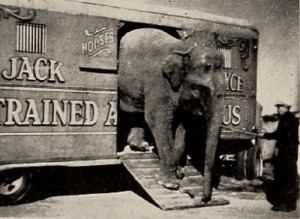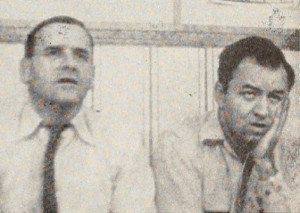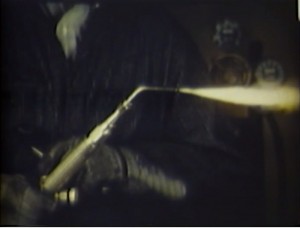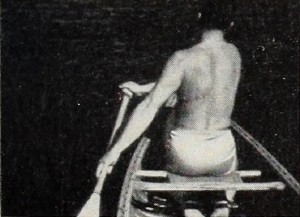
"What happens behind the scenes is always of interest to curious people — and most of us are curious. Remembering the delighted boys who sometimes get odd jobs in the backyard of the circus, Guy Nelli elected to let us see what they have seen, in Outside the Big Top. Not once are we shown the performance for which the whole effort is made, since Mr. Nelli very properly stays outside with his camera. Beginning with interesting and well filmed scenes of the circus in its early morning arrival, Mr. Nelli shows us how the Big Top is set up and carries us along until the show has ended. Odds are that he is a persuasive talker as well as a fine movie maker, because he got some of the best portrait and "candid" scenes of the performers that one will meet in many a day." Movie Makers, Dec. 1945, 496.

"Long a chef du cinema of pleasant family films concocted with a comedy flavor, George Valentine, has once again stirred up his favorite recipe. Outsmarted Smarties is a lively tale of a couple of mischievous husbands being outwitted by their wives. In his film, Mr. Valentine has combined clear plot structure, good cutting and sparkling lighting (especially in the interior scenes), to tie up a neat package with a punch ending. The acting is consistent with the demands of the story, and the attractive titles are intelligently inserted only where they are needed." Movie Makers, Dec. 1952, 339.
"'Overdose,' filmed by Francis J. Barrett, of Seattle, Washington, is an expertly photographed dramatic photoplaylet, done in 8mm. black and white. The story concerns two young men sharing a room together. One, a writer is upset by annoying tactics of other who, sensing this, plans to put his friend out of his misery. He brings him a cup of coffee to which he has added sleeping tablets. A fight ensues and the other strikes his benefactor down with an ashtray. It is then he discovers the sleeping pills are not fatal. The plot is simple, but the acting is expert, and complemented by the dramatic low-key lighting and highly effective camera handling, presents a very professional bit of cinematic artistry. Barrett used a Bell & Howell 8mm. 'Sportster' camera and Ansco Hypan film." American Cinematographer, Apr. 1950, 134.

"Good teaching films are not easy to produce, and welding activities are not easy to film. In making this picture, Ray Garner and the Harmon Foundation have solved both problems in a highly satisfactory manner. The procedures are clearly and simply outlined in titles which are combined with unusually fine camera work, to produce a well integrated whole. Done almost entirely in closeups, the actual welding scenes show perfect exposure and, in many instances, very interesting angles. The film was made at Hampton Institute, in Virginia, and a student demonstrates the proper techniques in procedure. The title art work was especially good in this film, and the entire production showed the effects of a well organized plan and a careful procedure." Movie Makers, Dec. 1942, 509.
"A compilation film illustrating patterns in nature through examples found on the Pacific coast. Includes varied tidal marine life and plants -- crabs, starfish, lobster, anemones, clams, etc. Discussion of patterns in form and structure, behaviour and natural association." (BC Archives)

"To realize that paddling bow position in a canoe can be the sole subject of an entire film should surprise any reasonable movie maker. But when you consider that Paddle Up Front! is a physical-education teaching film, it is not so surprising. Naturally, the continuity treatment is repetitious, as all teaching-film plans are likely to be. But C. Roy Terry, jr., production director, ably demonstrates that the person who occupies the forward position in a canoe has an important job when it is done properly. The photography by Ellis A. Ring is workmanlike, particularly in cross lighted scenes which point up the muscle movements in various strokes by the paddler. The didactic narrative seems unnecessarily obvious in places, but it probably is justified when one considers the specific purpose of the film." Movie Makers, Dec. 1950, 468.
"Hacía un alegato sobre lo que sucede al otro lado de la tranquilidad de la vida burguesa. Se alternaban imágenes de placidez doméstica de la clase media con escenas de la guerra de Vietnam y las rebeliones estudiantiles de la época. Al final de la cinta, sobre la fotografía de un mitin en Tlatelolco, una pregunta: "saber, darse cuenta, ¿cuándo?" "(Vázquez Mantecón, 2012).
"It was an allegation about what happens at the other side of the bourgeois life tranquility. Images of middle class house placidity were alternated with scenes from the Vietnam war and the students' rebellions of the time. At the end of the film, over the photography of a political rally in Tlatelolco, a question: "to know, to notice, when?" " (Vázquez Mantecón, 2012).
"Scenes from Croston village pageant, Saturday May 26th, 1951 - adults and children are seen in medieval dress, acting out scenes from the area's history. A number of 'Coffee Day' parades from 1937 to 1970 are shown, with Church groups and floats passing through the streets. The film ends with a man and two women in the garden of a house in Steyning, West Sussex." (NWFA Online Archive)
Total Pages: 299